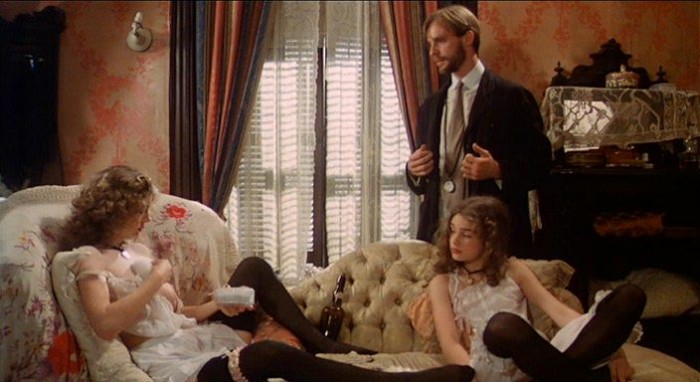“Storyville, New Orleans, 1917.”
This is the title card that opens Louis Malle’s Pretty Baby. The film tackles the scandalous topic of child prostitution in a strikingly elegant and elegiac fashion through chronicling an upscale brothel in one of New Orlean’s most notorious red-light districts. Madame Nell (Frances Faye) is an old and cynical matriarch who runs the brothel that the film centres on. With an acute attention to detail, most likely due to his love for period pieces, Malle brings Nell’s bordello to life in such a way that even the viewer finds the place endowed with homeliness and comfort.
The first shot of the film is a close-up on the face of a beautiful little girl. This girl is Violet, played controversially by a 12-year old Brooke Shields. Shields’ talent as an actress remains questionable, but Malle demonstrates a deft ability in capturing her expressive face and youthful spirit. As the camera tightens on her awestruck expression in this opening shot, the viewer realizes that Violet is witnessing her mother Hattie (Susan Sarandon) give birth to a baby boy in bed. Like her new half-brother, Violet is herself a “trick-baby,” or a child of a prostitute and an unknown father.
Through Violet’s curious perspective, the viewer perceives the dynamics of Nell’s whorehouse. Aside from the working girls, “Professor” (Antonio Fargas), a black pianist, amuses the guests with his music in the drawing room, and later an eccentric photographer named Bellocq (Keith Carradine) arrives with an interest in photographing the prostitutes. Bellocq is loosely based on actual Storyville photographer Ernest Bellocq. He is eccentric and enigmatic, spending bountiful time at the house while never asking for any services. In a sense, Bellocq is a true artist, deriving the most pleasure out of freezing the world around him through capturing moments in time.
Violet’s dichotomous character is defined by precociousness and innocence. In one of the most disturbing scenes of the film, Violet’s virginity is auctioned off. Malle cuts between shots of Violet, her hair curled and face done up with makeup, to close-ups of the sun-spotted, gray-haired men wishing to deflower her. Standing on the pedestal, Violet waves to Bellocq, whose stolid expression emanates a quiet outrage.
When Violet arrives at Bellocq’s house one day, she asks him if she can stay with him. When he replies yes, she tells him: “I love you once, I love you twice, I love you more than beans and rice!” This childish declaration of love seems to epitomize their relationship, which mimics that of a parent and child despite its sexual intimacy. Bellocq even purchases Violet a doll, declaring, “Every child needs a doll.” Despite the visceral queasiness that an erotic relationship between a child and adult arouses, there seems to be some element of puppy love between Violet and Bellocq.
While Pretty Baby encountered controversy and scandal surrounding its production, Malle’s cool approach to the daring subject matter prevents the film from appearing exploitative. The film is mesmerizingly beautiful in its cinematography and smart in its study of physiognomy. Like Bellocq who finds beauty in a still image, Malle is fascinated by close-ups of the expressions of his characters. Therefore, much like the renowned ending to Francois Truffaut’s 400 Blows, Pretty Baby concludes with a freeze-frame of young Violet’s strikingly beautiful visage. As the credits begin to roll over the image of her face, the viewer realizes that Violet’s story is in fact an accurate documentation of a chapter in American history.








